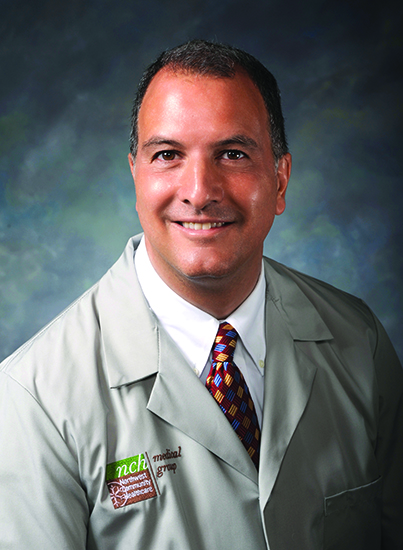Prostate cancer 101
September 17, 2019
What men need to know

Men, don’t procrastinate. It may be time to check your prostate. Here are some basic facts in our Prostate Cancer 101 crash course, courtesy of David Guthman, M.D., a board-certified urologist with Northwest Community Healthcare (NCH) Medical Group in Arlington Heights.
What and where is your prostate?
It’s a gland that sits in the male pelvis.
How do you keep it healthy?
In general, healthy nutrition is good for your prostate. Some researchers also look at specific supplements which may be good for you, but they don’t substitute for a well-balanced, nutritious diet full of fruits, vegetables and antioxidants.
What is prostate cancer and how common is it?
It’s cancer of the prostate gland. Next to skin cancer, it’s the most common cancer in men. Luckily, it’s a very rare form of mortality for men. Most men don’t die from it, but with it.
What are the first signs of an enlarged prostate?
Signs include a weak or slow urinary stream, getting up frequently in the night to go, starting and stopping, or a feeling that you haven’t fully emptied your bladder. You might be going several times per day and getting up multiple times per night.
What are the symptoms or warning signs of prostate cancer?
There are many symptoms of prostate obstruction, irritation or infection such as burning or pain with urination, loss of bladder control, blood in the semen, erectile dysfunction and decreased urine flow. However those signs are not typically caused by cancer. There are no warning signs or symptoms of localized prostate cancer, which is why it’s important that we do screenings. The only way to detect it and get an early diagnosis is by routine screening.
The American Urological Association (AUA) supports screening men ages 55 to 69. African-American men are at higher risk. At NCH, we recommend an annual PSA (prostate-specific antigen) blood test and a digital rectal examination (DRE) of the prostate.
Is the DRE screening painful?
No, it’s a brief, digital examination involving minimal rectal pressure.
What can patients expect from a visit?
We collect a medical history, perform a physical examination, collect a urine sample and conduct a PSA blood test.
What is considered a high PSA?
The AUA does not consider a specific number, but rather the relative change from year to year to be important. A low PSA rise is a reassuring piece of information; a larger PSA rise is what triggers further evaluation.
What’s involved with further evaluation?
It could be additional biomarker testing, which could involve imaging of the prostate by ultrasound or by MRI. Or it could involve evaluations over time, a biopsy of the prostate and/or all of these things together.
What treatments are available at NCH?
NCH offers treatment options such as precision medicine, robotic-assisted surgery, Cyberknife® radiosurgery, image-guided radiation with the Halcyon™ system, brachytherapy, hormone therapy (androgen deprivation) and active surveillance.
Who is at risk for prostate cancer?
Every male is at risk, but there is an increased risk for African-American men, those with a family history of prostate cancer and those who are obese.
NCH is raising the standard of care for patients with prostate cancer. Our prostate program brings together advanced technology, a multidisciplinary team of specialists and personalized services, including a prostate cancer patient navigator who is available to guide and support you throughout your care.
For more information, visit nch.org/NoWait or call 847-618-9688.
For more information, visit nch.org/NoWait or call 847-618-9688.